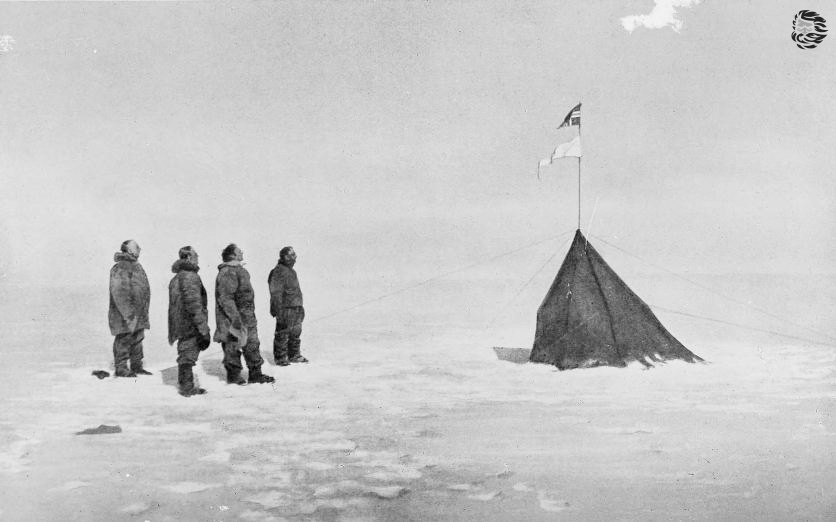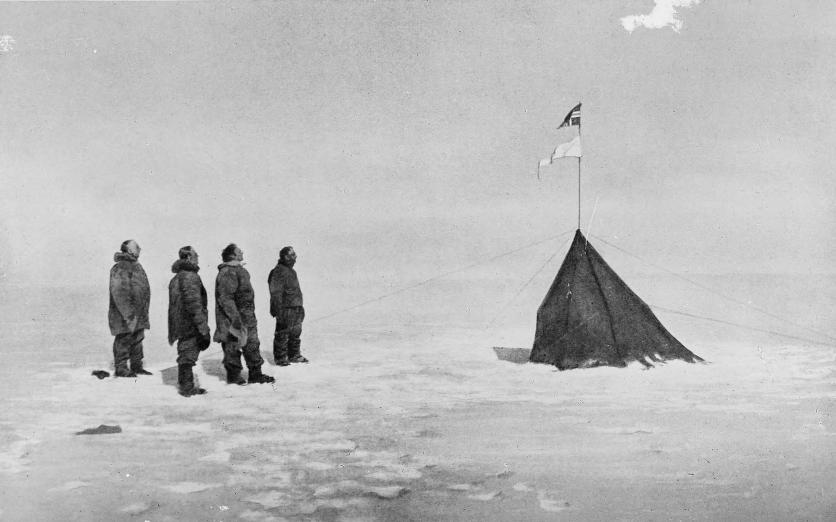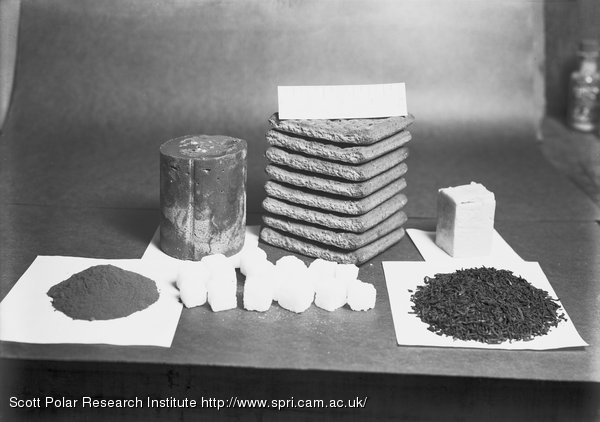
If you are unreliable, then you should not lead a polar expedition.
Although if you are arrogant to the extreme, how can you guess your own incompetence?
The history of the conquest of the South Pole is a ready-made management textbook. Fortunately, we have an example of two leaders acting in the same situation, literally a spherical model of management in a vacuum. Here you have the same task and conditions, show you how to do it and how not to do it.
The crux of the matter: in January 1911, two expeditions landed in Antarctica: the British by Robert Scott and the Norwegian Roald Amundsen. Both wanted to reach the South Pole, the last place on Earth that humans had not yet visited. The groups overwintered off the coast and started to the Pole almost simultaneously. Whoever did it first should have gotten all the glory.

Canonical map of the routes of the two expeditions
We walked along parallel routes. For the Norwegians, the path from the bay to the pole was a little shorter, but they followed an uncharted path.
The British followed the road already explored by the Briton Ernest Shackleton in 1907. Then he did not reach the pole 180 km.
However, Amundsen and his group arrived at the pole earlier, hung out there for three days and returned safely to the base. Scott and four of his companions were at the pole 34 days later than the Norwegians. And everyone died on the way back. Three still had a chance to survive, but they froze in the tent without food or fuel, while waiting for the storm for 9 days. They had only 18 kilometers to go to the salvage warehouse with food and kerosene.
Scott's expedition was poorly planned and organized. This should be the responsibility of the commander. But all was redeemed by heroic death. After 8 months, a rescue expedition from the coast found a tent with corpses. They found Scott's letters and diary, photographic materials and even geological samples, which the expedition did not abandon to the last.
In the eyes of the world community, Scott remains a hero, a worthy representative of the British nation. And Amundsen is an unpleasant type who almost stole the victory from Scott.

Roald Amundsen, Helmer Hansen, Sverre Hassel and Oskar Wisting at the South Pole in December 1911 (From the archives of the National Library of Norway)
Here is a typical British newspaper report:
“Scott came second to the pole. Amundsen - the penultimate! "
If an investigation were carried out in hot pursuit and conclusions were drawn - could this help the British better plan major operations, such as the landing at Gallipoli? Oh, well, some kind of nonsense.
Let's walk through some aspects of the expedition and evaluate Scott and Amundsen's different approaches to planning and managing people.
1. People
Who will you take to walk 1,300 km through the icy desert and mountains?
(and then the same amount back).
Well, probably trained skiers or experienced polar explorers?
Scott's coastal party consisted of 65 people: naval officers, scientists, ordinary sailors. The group for the final dash to the pole was supposed to consist of four people, including Scott himself:
- Edward Wilson - zoologist, physician and artist
- Lawrence Ots - cavalry, contributed £ 1000 to the expedition fund for the right to go to the Pole
- Edgar Evans is a sailor.
But already on the way, Scott took the fifth person into the group, although the food was calculated for four. The fifth was Henry Bowers, a naval officer. There were four pairs of skis - Lawrence Ots gave his skis to Bowers and went on foot.
Amundsen had only 9 people in the coastal party. There were also five in the group for conquering the pole - all experienced skiers and polar explorers. I will not give names, why memorize them if they did not die as heroes?
2. Transport
How to get supplies?
Scott was an experienced polar explorer, in 1901-1903 he already led an expedition to Antarctica. I learned everything from experience, but not the fact that I made the right conclusions.
I was skeptical about: dogs and skis.
Allowed the use of horses (Manchu breed).
But the main stake was on pedestrian traction.
The plan was as follows: from the coast, the equipment is cast in motor sleds (3 pieces). Next is a caravan of horses and dogs. And on the final dash (700 km to the pole) - people pull the load.
The snowmobiles did not help. The first drowned while unloading from the ship. The other two did not last long and soon went out of order.
A problem has emerged with horses - they do not tolerate the cold well, for the night they need to build a wall-shelter. Plus they have to haul their own forage. Plus, not every snow suits them - on the way it turned out that they sink deeply with their hooves.
Scott also had dogs, one of the drivers was the Russian peasant Dmitry Girev. But dog sleds were used for auxiliary purposes - to throw food into an intermediate warehouse. Scott did not take the dogs to the Pole.
Amundsen relied on dogs and skis.
On the ship, 52 Greenland huskies sailed with him.
Dogs run well in sleds on any snow. At night they burrow into the snow and do not freeze. They feed on dried fish.
And the main life hack with dogs - in the middle of the way, one of them can be shot, and the rest can be fed with their meat.
The murder schedule was calculated, which allowed us to take more food for the people.
Despite the planned killings, 11 dogs safely returned to the coast and sailed to the mainland.
Yes, and skiing. While the dogs ran in sleds, people ran alongside on skis.
3. Food
The diet for both expeditions was approximately the same, the daily dose was 4500 calories:
pemmican (dried meat with fat), milk powder, chocolate, biscuits.
Amundsen used a little more fresh meat - seals (harvested earlier on the coast) and dog meat.
Plus Amundsen tested a novelty: pemmikan with the addition of dried vegetables and oatmeal (sponsored by the Norwegian army). Norwegians suffered less from vitamin B12 deficiency.
And due to the fact that they were quickly driven to the pole and back, they did not have time to get sick with scurvy.
Amundsen calculated the food with a supply, on the way back they even dumped excess food.

The daily diet of the expedition member Scott: cocoa, pemmican, sugar, cookies, butter.
Once the Norwegians met an emperor penguin at their tent. They killed him and ate him (true story).
Scott, in principle, had everything calculated with the amount of food (except for the extra eater on the final dash to the pole), but the problem turned out to be with calorie consumption. The British spent an average of 5,500 calories - a thousand more calories than the Norwegians, because they carried everything on themselves. Now imagine this happens every day. People were weakening before our eyes, the body made up for the lack of calories at the expense of muscle mass.
4. Intermediate warehouses
Each expedition set up warehouses with food and fuel along its own route.
Scott did it simply: here's a food tent, put a flag on top.
Is it logical? It's logical, just try to find it on the way back. If your tracks are covered with snow, and there is a blizzard outside.
And Amundsen marked each warehouse with a string of flags:

As a result, the British had to spend extra energy to find their own supplies.
The most tragedy happened with the Scott's warehouse closest to the base called "One Ton". When they were carrying provisions for him before the start, everyone was very tired. Scott took pity on the people and allowed to build a warehouse not on the 80th parallel, as planned, but a couple of tens of kilometers further from the pole.
On the way back, these few kilometers became critical, people died a step away from salvation.
5. Evaporated fuel
On the way back, Scott's people found cans of kerosene in warehouses half empty - a tin ration failed, which cracked in the cold. As a result, the kerosene evaporated.
Amundsen had a better situation with this.
Researchers in 1929 found a Norwegian canister - kerosene was still present there.
6. Planning back to back
Amundsen, when calculating the route, left every fourth day to rest. So that the group can just stay in tents and recover all day.
It was useful to them when climbing the Axel glacier, when they got into a terrible blizzard and the progress slowed down. In the end, the schedule was not violated, there was enough food.
Scott did not allow accidents and delays in the calculations, did not leave any margin of time.
He kept saying, "We cannot afford to be delayed." In preparing the four-month trip, he did not include in his plans the possibility of bad weather, even for four days. In the worst case, as Bowers noted in his diary, "the delay would only mean a small shortage of provisions on the way back, but that's small things." Little things! This is with their calorie deficit!
Total: under the same initial conditions, one group completed its task and returned home, the second died heroically. The details of the death of the British expedition touch the soul.
Edgar Evans suffered a head injury from a fall and died a day later.
Lawrence Oates, when he realized that he could no longer walk and did not want to delay the others, said: "I will walk a little and will not be back soon." He left the tent without shoes and did not return.
The remaining three walked as long as the weather allowed. Winter came earlier than usual and turned out to be much harsher than one might have expected. Bowers and Wilson died first, Scott covered them with blankets, collected diaries and letters, and died himself.
His last entry was "for God's sake, take care of our loved ones."
Diaries and letters were published, and a collection of donations was announced in Britain.
The money was enough to pay off the debts of the expedition and to retire the relatives of the victims.
Scott became a national hero.
The author of Peter Pan wrote: "There is no Briton who does not feel a surge of pride in these days, having learned from the message written in the tent what his tribe is capable of."
The memorial service was held in St. Paul's Cathedral, the ceremony was attended by all the highest ranks of Great Britain, led by the king.
And Amundsen was received in Britain with a scandal: the president of the Royal Geographical Society, George Curzon, made an ambiguous speech. Amundsen described this episode as follows:
«… , , , , : « „“ », — ...»
The heroic image of Robert Scott began to be rethought only in the second half of the 20th century.
British journalist Roland Huntford published the book "Scott and Amundsen" - in fact, I am retelling it today. Where I went through the details of the expeditions in detail and showed the difference in approaches.
Scott, of course, is a hero, but at the same time a self-confident arrogant person who does not know how to admit mistakes and learn from his own experience.
Would you go on an expedition with such? And into battle?
And in peacetime, would you be engaged in a joint project?
Do not think that heroic carelessness is only a British trait. Literally in the next year, 1912, three Russian Arctic expeditions disappeared - and there was not everything in order with the organization. Time to reread The Two Captains - who is to blame for the death of Captain Tatarinov's expedition?
Take care of yourself and choose the right leaders.
Related materials:
Finally, a quote from Amundsden:
“In such a campaign, victory is ensured not only by money, although, God knows, it is also very good to have more, yes, perhaps, I dare say, to the greatest extent here is the method by which the equipment for the campaign is carried out - the method, when which foresees every difficulty and finds means to deal with it or avoid it. Victory awaits the one who is all right - and this is called luck. Defeat certainly befalls the one who neglected to take the necessary precautions in time - and this is called failure. "
Author: Yuri Detochkin
Macleod VDS servers are fast and secure.
Register using the link above or by clicking on the banner and get a 10% discount for the first month of renting a server of any configuration!
